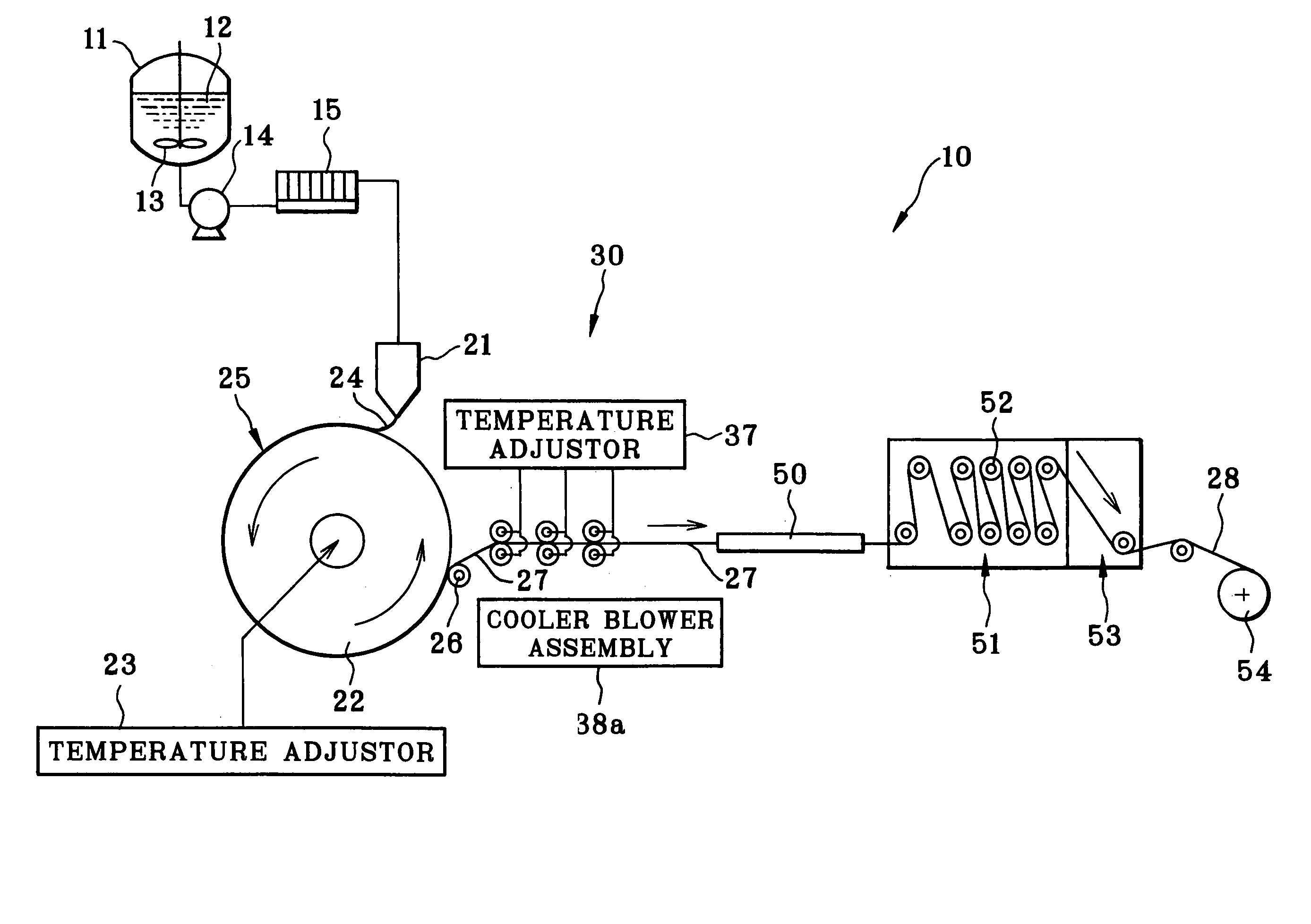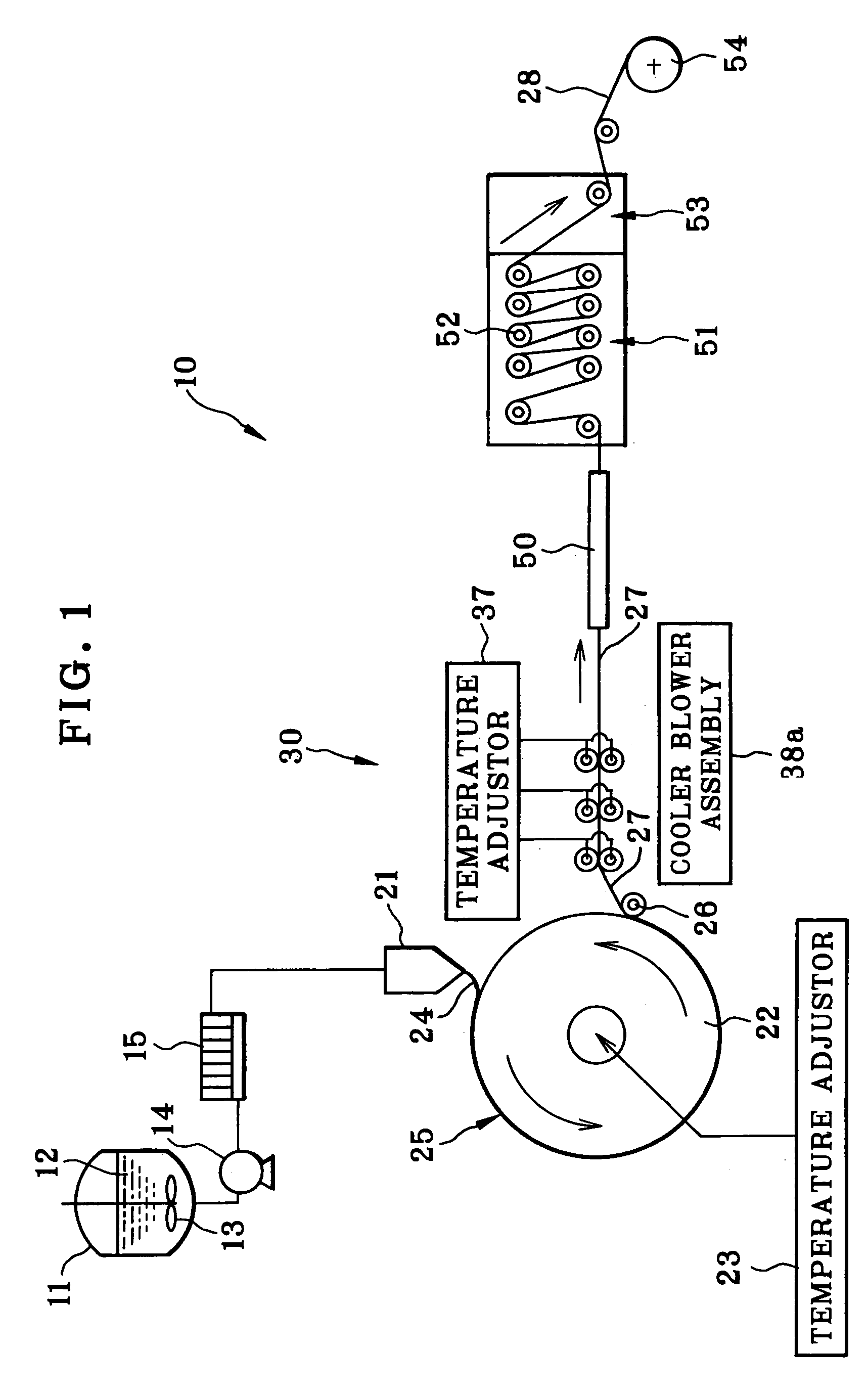Solution casting process for producing polymer film
a technology of polymer film and casting process, which is applied in the direction of manufacturing tools, other domestic articles, coatings, etc., can solve the problems of low solubility of cellulose acylate to solvent, low solid content density of dope, and low strength of gel film, etc., to achieve the effect of suppressing wrinkles
- Summary
- Abstract
- Description
- Claims
- Application Information
AI Technical Summary
Benefits of technology
Problems solved by technology
Method used
Image
Examples
examples
[0105]Preferred examples of the invention are hereinafter described. At first, preparation of the dope for use in the experiments is described. Experiment 1 was conducted for observing wrinkles of the self-supporting film and residual adhesion to the self-supporting rollers. For Experiment 1, details of the condition are described with Example 1 and Comparable examples 1–6. Portions of the condition in Comparable examples 1–6 the same as those of Example 1 are not further described. Results in relation to the condition are indicated in Table 1. Then Experiment 2 was conducted for observing occurrence of curls. Specifically, portions of the condition in Experiment 2 the same as those of Experiment 1 are not further described. For Experiment 2, details of the condition are described with Examples 2–4 and Comparable examples 7 and 8. Portions of the condition in Examples 3 and 4 and Comparable examples 7 and 8 the same as those of Example 2 are not further described. Results in relatio...
experiment 1
Example 1
[0110]The polymer film producing system 10 in FIG. 1 was used for the polymer film production. The solution casting die 21 was a coat hanger type of die. A surface of the supporting drum 22 was subjected to plating of hard chromium, and finished according to the mirror surface finish in order to impart a surface roughness of 0.04 S to the supporting drum 22. The feed rollers 31–36 in the transition unit 30 had surface roughness Ra of 0.2 micron, static friction coefficient μ0 of 0.04, and dynamic friction coefficient μ of 0.02. The ratio V2 / V1 of the peripheral speed V2 of the lower feed roller 36 to the peripheral speed V1 of the lower feed roller 35 was determined 1.05. The ratio V1 / V0 of the peripheral speed V1 of the lower feed roller 35 to the peripheral speed V0 of the lower feed roller 34 was also determined 1.05.
[0111]After the above conditions are determined, the dope A at 30° C. was cast on to the supporting drum 22 at the casting speed of 50 meters per minute in ...
comparable examples 1 – 6
Comparable Examples 1–6
[0112]The solution casting of the condition was the same as Example 1 but with differences specifically indicated in Table 1. In Comparable example 2, the self-supporting film was cast with a thickness of 25 microns for the purpose of finely forming the polymer film with a thickness of 17 microns. The condition and results of the experiment are indicated in Table 1.
[0113]
TABLE 1Comp.Comp.Comp.Example 1Example 1Example 2Example 3Modulus (Pa)500,000400,000500,000500,000of longitudinalelasticityThickness60252560(microns) ofthe cast film 27upon beingstrippedTemperature−53−5−5(° C.) of thecast film 27Surface rough-0.20.040.20.04ness Ra(microns) ofthe feed rollersStatic friction0.040.0340.040.04coefficient μ0Dynamic0.020.0170.020.02frictioncoefficient μRatio V2 / V11.051.0021.051.05between theperipheralspeedsStraining rate1.4 × 10−31.3 × 10−31.4 × 10−31.4 × 10−3(1 / s) in theextension ofthe cast film 27Occurrence ofACBAwrinklesOccurrence ofACABresidualadhesionComp.Comp....
PUM
| Property | Measurement | Unit |
|---|---|---|
| surface temperature | aaaaa | aaaaa |
| temperature | aaaaa | aaaaa |
| thickness | aaaaa | aaaaa |
Abstract
Description
Claims
Application Information
 Login to View More
Login to View More - R&D
- Intellectual Property
- Life Sciences
- Materials
- Tech Scout
- Unparalleled Data Quality
- Higher Quality Content
- 60% Fewer Hallucinations
Browse by: Latest US Patents, China's latest patents, Technical Efficacy Thesaurus, Application Domain, Technology Topic, Popular Technical Reports.
© 2025 PatSnap. All rights reserved.Legal|Privacy policy|Modern Slavery Act Transparency Statement|Sitemap|About US| Contact US: help@patsnap.com



